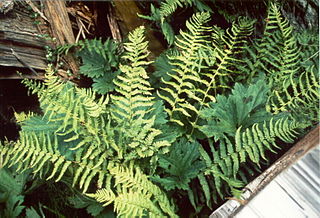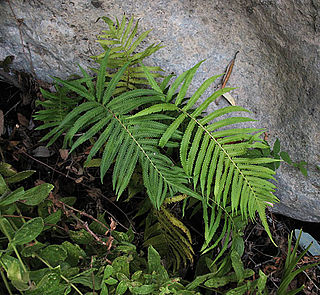
Ceratiola is a genus of flowering plants with a single species, Ceratiola ericoides, the sand heath, sandhill-rosemary or Florida-rosemary, is a species of shrub endemic to the Southeastern United States.

Grindelia squarrosa, also known as a curly-top gumweed or curlycup gumweed, is a small North American biennial or short-lived perennial plant.

Cunila origanoides, with the common names stone mint, frost mint, dittany, and American dittany, is a perennial late-summer-flowering subshrub with small purple flowers that is native to the central and eastern United States. It belongs to the Lamiaceae (mint) family and is the only species in the Cunila genus native to the United States. It grows in habitats such as dry forests and the thin soil around rock outcrops. This species has historically been cultivated for use as a medicinal herb, tea, and ornamental plant.

Dryopteris ludoviciana, the southern woodfern, is fern native to southern United States from Florida west to Texas and as far north as Kentucky and North Carolina.

Symphyotrichum laeve is a flowering plant native to Canada, the United States, and Coahuila (Mexico). It has the common names of smooth blue aster, smooth aster, smooth-leaved aster, glaucous Michaelmas-daisy and glaucous aster.

Thelypteris is a genus of ferns in the subfamily Thelypteridoideae, family Thelypteridaceae, order Polypodiales. Two radically different circumscriptions of the genus are in use as of January 2020. In the Pteridophyte Phylogeny Group classification of 2016, the genus is a very small one with about two species. In other approaches, the genus is the only one in the subfamily Thelypteridoideae, and so includes between 875 and 1083 species.

Calamagrostis canadensis is a species of grass, having three or more varieties, in the family Poaceae. It is known variously by the common names of bluejoint, bluejoint reedgrass, marsh reedgrass, Canadian reedgrass, meadow pinegrass, and marsh pinegrass.

Smilax glauca, the cat greenbriar or catbriar is a woody vine in the family Smilacaceae. It is native to central and eastern portions of the United States as well as Mexico, where it is a common and conspicuous part of the forest vegetation.

Amauropelta noveboracensis, the New York fern, is a perennial species of fern found throughout the eastern United States and Canada, from Louisiana to Newfoundland, but most concentrated within Appalachia and the Atlantic Northeast. New York ferns often forms spreading colonies within the forests they inhabit.

Thelypteris palustris, the marsh fern, or eastern marsh fern, is a species of fern native to eastern North America and across Eurasia. It prefers to grow in swamps, bogs, wet fields or thickets, fresh tidal and nontidal marshes, or wooded streambanks. The species epithet palustris is Latin for "of the marsh" and indicates its common habitat. It is the only known host plant for Fagitana littera, the marsh fern moth.

Lygodium palmatum is the only species of its genus native to North America. Unlike most species in the genus, this one, called the American climbing fern, Hartford fern, or Alice's fern, is extremely hardy in temperate zones.

Physematium obtusum, the bluntlobe cliff fern, is a common rock fern of Appalachia and eastern North America. It prefers a calcareous substrate, but also grows in neutral soils. It may grow on rock faces or in scree.

Pelazoneuron kunthii, synonyms Christella normalis and Thelypteris kunthii, sometimes known as Kunth's maiden fern or southern shield fern, is the most common of the maiden ferns in the southeastern United States south of the fall line. It ranges westward to eastern Texas. It usually grows in moist to dry terrestrial situations, but can also be epipetric. It often grows as a greenhouse escape in areas north of its usual range.

Parathelypteris nevadensis, synonym Thelypteris nevadensis, is a species of fern known by the common names Sierra marsh fern, Sierra wood fern, and Nevada marsh fern. It is native to western North America from British Columbia to the mountains of northern California, where it grows in moist wooded areas, streamsides, meadows, and seeps. It is known from two locations in Idaho, as well. Despite its name it is not found in Nevada, rather, it was named for the Sierra Nevada, where it does occur in the northern mountains. It produces a dense cluster of long, feathery leaves which may be up to a meter long. It is rhizomatous and it sometimes forms colonies. The leaves die back in winter. Each leaf is made up of leaflets lined with smaller segments. The undersides are glandular and resinous and sometimes hairy.

Christella puberula, synonym Thelypteris puberula, is a species of fern known by the common name showy maiden fern. The variety Ch. puberula var. sonorensis is known by the common name Sonoran maiden fern.

Myrica inodora is a plant species native to the coastal plains on the northern shore of the Gulf of Mexico, in the Florida Panhandle, the extreme southern parts of Alabama and Mississippi, eastern Louisiana and southwestern Georgia. Common names include scentless bayberry, odorless bayberry, odorless wax-myrtle, waxberry, candleberry, and waxtree. It grows in swamps, bogs, pond edges and stream banks.

Nabalus barbatus, the barbed rattlesnakeroot, is a plant in the family Asteraceae. It is native to the Southeastern United States where it is found in small numbers in a few disjunct areas of remaining natural grassland. Because of this, it is considered a globally rare species, with only 35-70 remaining populations. Much of its natural habitat of prairie and savanna has been destroyed. In 2010 it was reclassified from the genus Prenanthes to Nabalus.
Sagittaria papillosa, the nipplebract arrowhead, is a plant species native to the south-central United States.
Thamnobryum alleghaniense, the Allegany thamnobryum moss, is located in temperate regions, mostly in the Northern Hemisphere. This moss has drooping branches at the top of a standing stem, resembling small trees in a micro forest. T. alleghaniense is common on rocks in moist, wet, and shady gorges and ravines. Leaf shape is ovate (-oblong), sometimes lanceolate or ligulate. Seta is 10-25mm. Contain dioecious reproduction, and rarely polyocious.

















